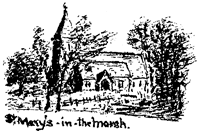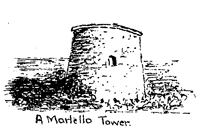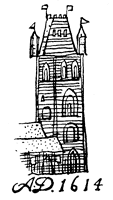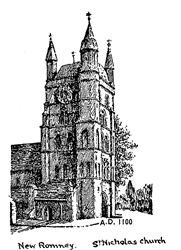 |
AROUND AND ABOUT Revised 1966 ITINERARY IDEAS A FEW WORDS ABOUT ROMNEY MARSH |
||||||
|
|
|||||||
|
CONTENTS Marsh Frogs | Smuggling | Cinque Ports | Excursions | Dymchurch | New Romney | Hythe | Saltwood | Dungeness | Lympne | Folkestone | Dover | Canterbury | Chilham | Ashford | Appledore | Tenterden | Smallhythe | Bodiam | Battle | Winchelsea | Rye | Brookland | Lydd | References PART II In describing excursions, St. Mary's Bay has been taken as the point of departure and return. The tours are divided into three categories:—
I. Within Easy Walking Distance For those who for reasons of economy desire to restrict their activities to within walking distance there is ample of interest to gorge any young mind between New Romney, St. Mary-in-the-Marsh and Dymchurch for the juniors and a little further afield, for those with longer legs. The walks may be taken in circular fashion so as not to cover the same tracks on the outward and homeward journeys. Country lanes and rural scenes all provide sources of interest to young and old alike. To the northward of St. Mary's Bay is the site of an old moated grange recently pulled down. Here stood the farm house of Old Honey Child reputed to have been built on the site of an earlier dwelling occuoied by Hengist and Horsa. It was at Old Honey Child that Wat the Tyier and the leaders of his rebellion met in 1381 and whence they set out for London. The remainder of the story as to how he met the young King Richard II, son of the Black Prince, who promised him and his followers pardon and fair play is too well known to require repetition here. Alas, the interesting old house was much dispoiled and neglected during the 1939-45 war and has lately been demolished as being unsafe. A little further on nestling amongst a few trees is the picturesque church of St. Mary-in-the-Marsh dating back to the XIII century. Noel Coward and his mother stayed in the cottage next to the Star Inn whilst writing "The Queen was in the Parlour."
Turning to the eastward we wend our way along winding lanes to Dymchurch, about which Russell Thomdyke has written his famous series of novels featuring the immortal Dr. Syn. The village is of considerable antiquity as witness the discovery near the wall of Roman coins of the 1st century B.C. Time has worked many changes, as too has the development of the ancient sea wall, first started by Roman enterprise. The village is now a holiday resort and its residents law-abiding citizens unlike those so aptly described in the story books. There are several interesting old houses. New Hall, built in Elizabethan times and till recently the Court House, has many interesting stories to tell could it but speak—of smugglers and wreckers and excise men, and the illegal activities of many under the cover of marsh miasmas and mist. The government of the Marsh until comparatively recent times was vested in the Bailiff, Jurats and Lords of the Level, together being known as the "Liberty of Romney Marsh." Annually is held at New Hall the time-honoured "Grand Lath" or meeting of the traditional governing body of the Marsh. The business conducted today at such meetings is purely traditional in character. Here it was in times past that sheep stealers and other criminals were tried, convicted and sentenced to swing by the neck from the gibbet until dead. Recently an old figurehead has been moved into New Hall from a local builder's yard, where it had remained for many years. This prompted many enquiries from visitors. It is said that the good ship 'City of London' was driven ashore in a south-easterly gale, and wrecked on the wall where now stands the tavern by that name in Dymchurch. The figurehead which was recovered from the wreckage according to legend is said to contain hiding places behind the eye balls for the secretion of jewels or precious stones when being smuggled ashore. A story which certainly lends colour to the activities of the XVIII and XIXth centuries in these parts.
Of Martello Towers there are several in this district. These time-honoured fortifications were erected when England was scared that Napoleon might land on these shores to overthrow his last real rival in Europe. Each was to have housed a small garrison and mounted two or more cannon. The walls are some twelve feet thick, and whilst never were they required for the purpose for which they were first constructed, not a few have served as fire control and look-out positions for the batteries stationed along this coast during the 1939-45 war. Some have subsequently been turned into private dwellings. Turning to the westward there is New Romney, which provides scope for another excursion along different roads with varying scenery and topics of interest. For those with a flare for bird life there is a veritable bird sanctuary in some water-logged disused gravel pits little over a mile from St. Mary's Bay Holiday Camp on the right hand side of the main road. Here swans may be seen nesting, besides a large variety of smaller birds some of which are comparatively rare in this country. A fair morning's walk is that to the ancient Cinque Port town of New Romney which should not be excluded from the programme of anyone visiting Romney Marsh. It is a round trip by the most direct route of 5 1/2 miles steady walking, all on the flat, which may be made more interesting by going out one way and returning another for the addition of 3/4 mile more. For the less energetic the Romney, Hythe and Dymchurch Light Railway provides an alternative mode of locomotion, incorporating the excitement of travelling upon the smallest public railway in the world. New Romney now stands some 1 1/4 miles from the sea though in Roman times it was a flourishing sea port town, situated as it then was, upon the river Rother, with an estuary opening into the English Channel where now stands Littlestone. The bed of the river can yet be traced alongside the main road leading from New Romney to Snargate along the Rhee Wall, and is well defined save at one or two points. The harbour, together with its wharves, was located at the south eastern boundary of the present churchyard of St. Nicholas' church. All that now remains to mark this once thriving port is a rather stagnant dyke. The church of St. Nicholas dates to the 12th century, and is in the Norman style of architecture with certain 14th century modifications in the perpendicular style.
The original church was of pure Norman design, without tower and apsidal at its eastern end. Caen stone has been employed in the majority of the stone work. The tower of late Norman work was added in the early 13th century, and presents a very fine example of the architecture and building of that date. It was originally surmounted by a low dumpy spire, only the base of which can now be seen as forming the parapet on the summit of the tower between the cupolas at the four corners, each of which is of a different design, and only one at the south western angle being probably part of the original structure. This contains the newel staircase by which the roof, belfry and ringing chambers are reached. It is of interest that in all likelihood the present flooring to the ringing chamber which can be seen from the ground floor was not fitted until the 16th or even 17th Century, before that date it is probable that the tower was open inside as far up as the belfry. This is borne out by the presence of an ambulatory in the outer walls at the level of the present ringing chamber.
Before leaving the tower, and entering the church through the 17th century screen, it is interesting to examine the eastern wall which was the original western outside face of the first Norman church. The door and arch of this church are now in the west face of the tower. The nave and small north aisle are all that remain of the original church which was enlarged to its present plan in the 14th century, when the existing chancel, with the two chapels were built to replace the Norman apse. The roof was originally of a higher pitch than it is today, and the clerestory windows over the semi-circalar arches of the main arcade gave upon the outside to increase the lighting of the building. The cylindrical shape of the Norman pillars was apparently considered not to be in keeping with the more modern style of architecture of the 14th century and consequently alternate columns have been shaved down to octagonal cross section.
In the east wall of the southern of the two eastern chapels known as the Stuppenny chapel is a small rectangular window at eye level, giving a view across the churchyard. In the 14th century the south coast had on several occasions been raided by parties of Frenchmen who had burnt and pillaged not a few of our towns. The people of New Romney, fully alive to this threat, took no risks of being caught unawares. Had not both Rye and Winchelsea suffered on the Lord's day whilst the devout were at church? Here, therefore in New Romney, a sentry was stationed within the church with a full view of the estuary so that he could raise the alarm should need arise, and so relieve anxiety from the minds of all who came to worship. There are also two squints in the wall screening the central or high altar. Their counterparts in the outside walls have been located, though they still remain bricked up. These were for the use of lepers and others to observe the celebration of Mass when they themselves might not enter the church. On leaving the church a visit to the Town Hall in the High Street is most instructive. There are a number of relics and records of bygone ages in the old Court Room on the first floor. Here too, may be seen copies of old maps which illustrate the change in the coastline and topography of Romney Marsh over the centuries. New Romney once at the height of its prosperity boasted seven windmills, and two churches the older of which, St. Martins was of Saxon origin and was pulled down at the request of the townspeople with Archbishop Cranmer's consent. Alas of this old place of worship now no records remain, and the grass grows lush where once stood a house of God. Almost opposite the site of this Saxon church may be seen the remains of the priory of St. John, now part of a private house. We in our day, have seen what storm and flood can do to change the face of the landscape. Here in New Romney we may see the scars of the great storms of the late 13th century and reconstruct in our minds the story of the havoc they must have wrought. Much has been written about the terrors of that storm when by force of the wind the tide ceased to ebb for two days and nights, and the flood was so mighty as to throw up great walls of beach to dam the outflow of the river Rother. Certain it is that the ferocity of the gale coupled with the strength of the seas and the darkness of the night struck terror into the hearts of all leaving destruction and dismay in the once flourishing port. The mouth of the river became choked with shingle to such a depth that the Rother burst its banks and changed its course to the westwards, carving out a new bed for itself towards Rye, till it entered the sea at a point near Camber. In the town itself, much shingle was flung upon the foreshore and the, "ancient church in dockland" was flooded. The degree to which the level of the foreshore was raised can be seen today by the fact that to enter the Church one now goes down a flight of steps instead of rising one or two as is customary when entering a building. Inside the church the columns in the nave bear the high water mark, stained deep into the stone, which even time over the centuries has been unable to erase. Thus it was that the prosperity of New Romney as a sea port town was cut short, and it was only a matter of time before even its connection with the sea became history. Before leaving New Romney and especially if you have travelled by light railway a visit to the miniature Railway Exhibition at the famous "Model Land" should not be omitted. Here a complete miniature railway system has been laid out under the most realistic conditions. The trains pass over bridges spanning flowing water, as the rivers cascade down mountain gorges. Village scenes are carefully portrayed beside the track to increase the atmosphere of reality. The whole is electrically controlled, and provides a great attraction to all visitors. Express and freight trains, all moving at the same time, pass one another and draw into stations with precision and dignity so fascinating to us all. From this sanctuary you may travel homewards by miniature train, or retrace your steps along the Sea Wall, though by the time you get out of Model Land you will not have much time to spare before your next meal. |
|||||||




